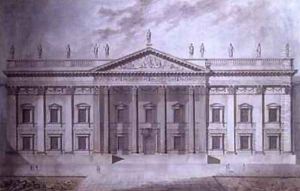Thomas Hardwick Paintings
Thomas Hardwick was an influential English architect, a prominent figure in the development of architecture during the late 18th and early 19th centuries. Born in 1752 in Brentford, Middlesex, he was the son of a master mason, also named Thomas Hardwick, which provided him a strong foundation in the building trades. He received his formal architectural training under the supervision of Sir William Chambers, a leading architect of the time, and developed skills that would serve him throughout his career.
Hardwick’s work was primarily in the neoclassical style, which was popular in Britain at the time, characterized by its adoption of classical Greek and Roman aesthetics and an emphasis on symmetry and proportion. He was involved in a wide range of projects, from the design of churches and country houses to the restoration of historic buildings. One of his most notable projects was the design of the St. Mary the Virgin Church in Wanstead, London. He was also involved in restoration work on the Westminster Hall and the Old Bailey in London.
Throughout his career, Hardwick was deeply involved in the architectural community. He was a founding member of the Architects' Club in 1791 and a fellow of the Society of Antiquaries. His contributions to architecture were significant, and he is remembered for his meticulous approach to design and for being a mentor to the next generation of architects, including his son, Philip Hardwick, who became a distinguished architect in his own right.
Thomas Hardwick passed away in 1829, leaving behind a legacy of architectural works that continue to be studied and admired for their craftsmanship and adherence to the classical principles of architecture.
